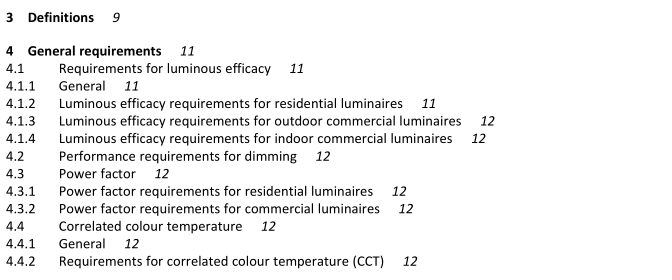CSA C866-17 pdf download – Performance of LED luminaires.
1 Scope 1.1 This Standard specifies energy efficiency and performance requirements for LED luminaires of the directional and non-directional type used for general illumination, including commercial and residential, indoor and outdoor, as well as those with a significant decorative function. Notes: 1) White tunable luminaires and connected luminaires are included in the scope of this Standard. 2) Safety requirements for luminaires, portable luminaires, self-ballasted lamps, and lamp adapters are provided in CSA C22.2 No. 250.0, CSA C22.2 No. 250.4, and CSA C22.2 No. 1993, respectively. 1.2 This Standard does not cover LED products that are a) intended for roadway lighting and street lighting luminaires covered under CAN/CSA-C653 and CAN/CSA-C811; b) direct current (DC) powered luminaires, e.g. PoE luminaires; c) intended for indication, e.g., traffic lights and exit signs and pedestrian crosswalk signs; d) exclusively intended for decoration or colour changing highlights, e.g., holiday lights, wall washing, and colour changing luminaires; e) intended for retrofitting into existing fixtures (LED retrofit); f) other solid state lighting (SSL) such as organic light-emitting diodes (OLEDs) and nanotechnology; g) integral to equipment or instrumentation and are installed by its manufacturer; h) specifically designed for use only during medical or dental procedures; i) specifically used in display cases, where the lighting is integral to the display case; j) integral to food warming and food preparation equipment; k) specifically used for plant growth or maintenance; l) an integral part of advertising or directional signage; m) specifically used for theatrical purposes, including performance stage, and film and video production; or n) specifically intended for television broadcasting.
1.3 In this Standard, “shall” is used to express a requirement, i.e., a provision that the user is obliged to satisfy in order to comply with the Standard; “should” is used to express a recommendation or that which is advised but not required; and “may” is used to express an option or that which is permissible within the limits of the Standard. Notes accompanying clauses do not include requirements or alternative requirements; the purpose of a note accompanying a clause is to separate from the text explanatory or informative material. Notes to tables and figures are considered part of the table or figure and may be written as requirements. Annexes are designated normative (mandatory) or informative (non-mandatory) to define their application. 2 Reference publications This Standard refers to the following publications, and where such reference is made, it shall be to the edition listed below, including all amendments published thereto. CSA Group C22.2 No. 250.0-08 (R2013) Luminaires C22.2 No. 250.4-14 Portable luminaires C22.2 No. 1993-17 Self-ballasted lamps and lamp adapters CAN/CSA-C653-13 Photometric performance of roadway and street lighting luminaires CAN/CSA-C811-13 Performance of highmast luminaires for roadway lighting DIN (Deutsches Institut für Normung) SPEC 5031-100:2015-08 Optical radiation physics and illuminating engineering — Part 100: Melanopic effects of ocular light on human beings — Quantities, symbols and action spectra IES (Illuminating Engineering Society of North America) LM-79-08 Electrical and Photometric Measurements of Solid-State Lighting Products NEMA (National Electrical Manufacturers Association) NEMA/ANSI C78.377-2015 American National Standard for Electric Lamps – Specifications for the Chromaticity of Solid-state Lighting Products NEMA/ANSI C82.77-10-2014 Harmonic Emission Limits — Related Power Quality Requirements for Lighting Equipment NEMA/ANSI C137.1 (under development) Lighting Systems — 0-10 V Dimming Interface for LED Drivers, Fluorescent Ballasts, and Controls
Colour changing luminaire — a luminaire designed to mix different colours to produce a variety of colour outputs. Commercial luminaire — a luminaire marketed and intended to be used in a commercial, industrial, or business environment. Note: The term excludes devices marketed for use by the general public or intended to be used in the home. Connected luminaire — a luminaire or retrofit that includes elements or instructions (hardware and software or firmware) required to enable communication in response to consumer-authorized energy or performance related commands. These elements can be resident inside or outside of the base luminaire or retrofit. Direct current (DC) powered luminaire — a luminaire enabled to operate off direct current (DC) and/or power over ethernet (PoE) control and distribution system. Correlated colour temperature (CCT) — the absolute temperature of a blackbody whose chromaticity most nearly resembles that of the light source. Directional luminaire — a luminaire having at least 80% luminous flux within a solid angle of π steradian (corresponding to a cone with angle of 120°).CSA C866-17 pdf download.
